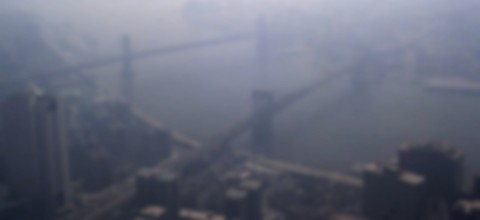NYU Gallatin student Ana Gabriele Sabancevaite reviews our event Dystopian Urbanisms held at NYU on April 5th.
What is the difference between a dystopia and a utopia? What would an urban utopia look like based on our urban developments? The Urban Democracy Lab panel on Dystopian Urbanisms introduced the audience to the dystopias that lurk in in the shadows of urban development. The dystopian manifestations of urban development blur the line between hope and fear about the outcomes of various development projects. Sometimes the panelists’ accounts of urban development projects would made it hard to determine whether they were talking about dystopia or utopia.
The Urban Democracy Lab brought together Liza Weinstein (Northeastern University), Gokce Gunel (Columbia University) and Carlos Forment (The New School for Social Research) to stretch the imaginations of the audience. Max Holleran (New York University) moderated the panel, which covered topics from science-fiction-like experiences in the deserts of Abu Dhabi, to the post-ideological state of a scavenger’s life in Buenos Aires, to life in a continuous state of housing insecurity against the backdrop of Mumbai’s housing developments.
Liza Weinstein opened the panel with her ethnographic research into the informal housing settlements in Mumbai. Their residents live under constant threat of eviction. Bulldozers could literally simply show up at their doorstep and provide a few minutes warning before striking through the building. This has been happening in Mumbai since the 1970s. Although the demolitions started in relation to a single urban development, even after the development was completed the bulldozing continued. Liza Weinstein posed the question: what politics are endemic to the environment of fear of displacement?
However, the grim reality of life under the threat of forced eviction is countered by the relentless resistance of the informal settlement and slum residents. Residents in these settlements have mobilized against the developers. They utilized their resources by filing countless lawsuits against the developers and using free speech to spread awareness of the situation, which could qualify as a human rights violation. As a result, the residents’ pushback succeeded in slowing down demolitions. The residents’ actions depict the heightened housing insecurity and how there is always room for resistance.
At the end of her presentation, Liza Weinstein left the audience thinking about the other side of resident and housing development conflict, namely the long-term effects of living in an insecure environment on resident well-being and how much time the residents have to invest in fighting for their right to housing.
Meanwhile, Gokce Gunel explored a cosmic housing development in the desert around Abu Dhabi: Masdar City. Nicknamed “Spaceship in the Desert,” the city is so modern it resembles a real life science fiction movie set. This utopia terrifies some due to its resemblance to the movie Blade Runner and its image of a world with genetically-engineered “replicants.” The resemblance is not far fetched since the “deserted” architectural environment of Masdar City is quite homogeneously skilled due to the fact that some inhabitants are drawn to the city by the fully-funded job placements at the Masdar engineering institute.
The other extremely attractive and ideologically appropriate installation in this utopian city is the organic food store. It is the only organic food store in the Abu Dhabi area and it is a frequently visited establishment in the city. Moreover, Masdar City can anticipate even more human traffic because construction of a Hilton Hotel is underway within its territory. It appears that it is just a matter of time for every city – utopian or dystopian – until a corporation starts its invasion.
However, the question of power supply brings the science-fiction cosmic city down to earth before the corporate invasion begins. The expansive solar power panel installation meant to power the city cannot stand up to the desert winds and dust. The two threaten the continuous supply of power because they dirty the panels. It turns out that this most modern and innovative technology cannot function without human labor. Only human labor can overcome the environmental threats to the livelihood of the city as a man with a brush remains an irreplaceable asset in times of technology and modernity.
The Masdar City presentation led the audience to think of the limits of any utopia – can utopia exist outside of its environment? Did the engineers not anticipate desert winds and dust? Can utopia exist free of human labor? Does it need to?
The last panel presentation continued from where Gokce Gunel finishes – the value of human labor. Carlos Forment invited the audience to get to know the life of a Buenos Aires scavenger. At the margins of visible urban economic structures, the scavenger’s life is a gateway to the informal economic sector that thrives within the urban environment. In spite of the efforts of the government and private businesses to penetrate and control these informal structures, the scavengers choose autonomous governance against any tangible financial and economic benefits, which would secure a stable income against the financial uncertainty of their profession. Carlos Forment’s presentation posed questions about the value of freedom and the right to own your own labor in the face of governmental or privatized interventions. It also highlighted the socio-economic benefits the scavengers can receive.
The waste pickers show the ability to collectively mobilize against formalization; however, the scavengers form only temporary alliances, which dissolve once they resist the threat. Forment’s research hints towards the existence of a post-ideological plebeian society of vertical justice, where the citizen represents their own interests directly. At first glance, the scavenger community in Buenos Aires seems dystopian, but can actually present a very utopian image of society governed by the principles of equality and autonomy.
What will urban utopias of tomorrow look like? Will we live on a spaceship or in fear of demolitions? Will we live in a modern society or outside of society? No matter how one will imagine the future utopias, the panel discussion on Dystopian Urbanisms reminded the audience that utopian and dystopian elements can coexist and some of them already exist parallel to mainstream urban life.

